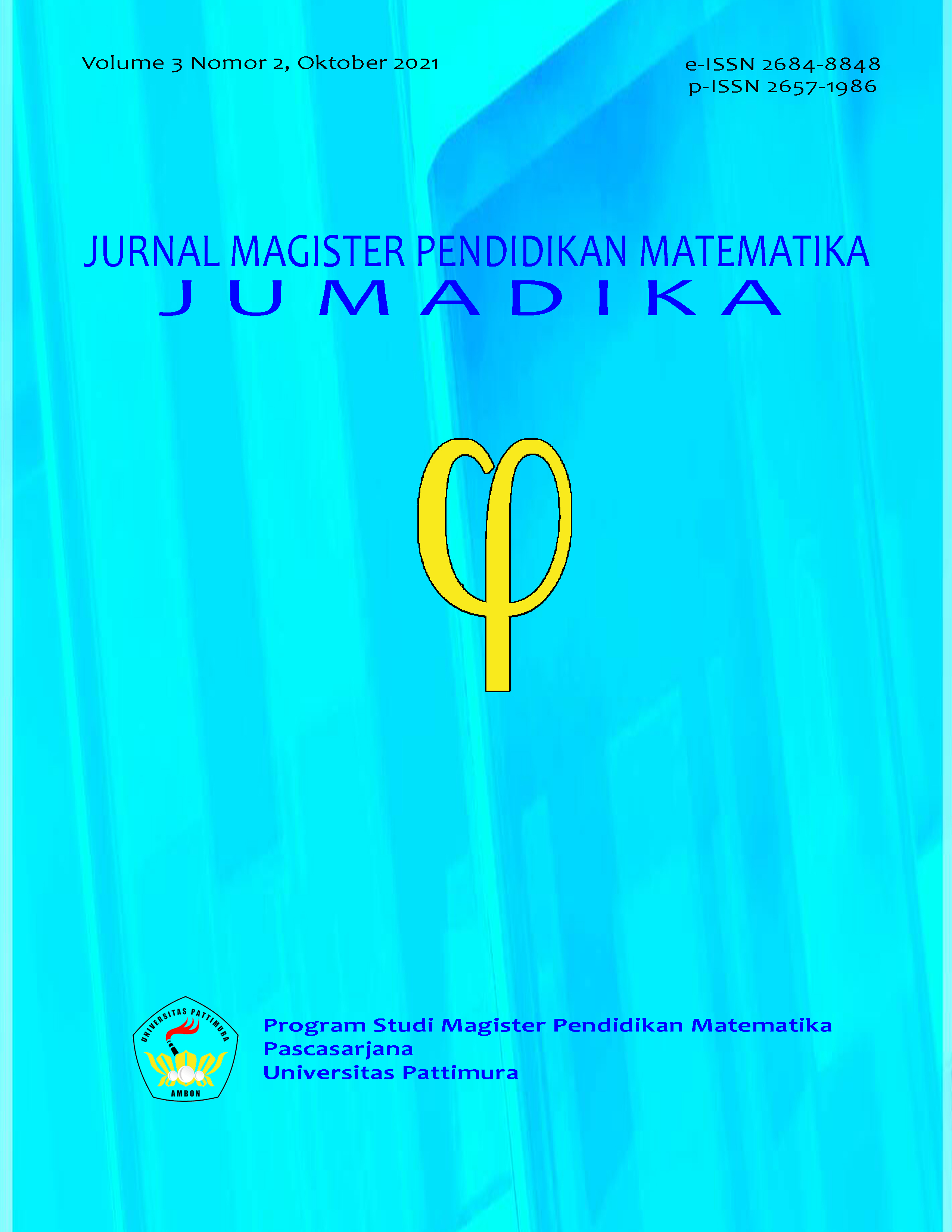MENGUKUR KETERLIBATAN SISWA DALAM PEMBELAJARAN ONLINE SISWA KELAS VII DI SEKOLAH ABC PADA PEMBELAJARAN MATEMATIKA
Abstract
Mengembangkan pemahaman tentang apa yang mendasari keterlibatan siswa dalam lingkungan pembelajaran online merupakan hal yang penting, khususnya Close Paneldi masa pandemi Covid-19 yang telah mengharuskan para pelajar mengikuti proses pembelajaran di rumah. Tujuan penelitian ini adalah untuk mengukur keterlibatan siswa kelas VII Sekolah ABC selama pembelajaran online dan menjadi bahan evaluasi untuk proses pembelajaran online. Metode penelitian yang digunakan adalah penelitian kuantitatif dengan tehnik pengumpulan data yang digunakan adalah menggunakan lembar kuesioner online menggunakan skala Likert 1 hingga 5 dan menggunakan Online Student Engagement Scale yang dikembangkan oleh Marcia D. Dixson. Hasil pengolahan data menunjukkan bahwa kuesioner online adalah valid. Berdasarkan hasil analisis uji korelasi menggunakan metode Chi-Square, diperoleh kesimpulan bahwa tidak terdapat korelasi antara keterlibatan siswa dengan asal SD sebelumnya. Sedangkan berdasarkan hasil analisis uji Mean menggunakan uji Z, diperoleh kesimpulan bahwa tidak cukup data untuk membuktikan bahwa terdapat perbedaan rata-rata keterlibatan antara siswa laki-laki dengan keterlibatan siswa perempuan.
Downloads
References
Carliner, S. (2004). An Overview of Online Learning. United States: HRD Press, Inc.
Dixson, M. D. (2015). Measuring Student Engagement in the Online Course: The Online Student Engagement Scale (OSE). Online Learning – Volume 19 Issue 4 .
Fredricks, J. A., & McColskey, W. (2012). The Measurement of Student Engagement: A Comparative Analysis of Various Methods and Student Self -report Instruments. Handbook of Research on Student Engagement, 763 - 782.
Fredricks, J.A., Blumenfeld, P., & Paris, A.H. (2004). School Engagement: Potential of the Concept, State of the Evidence. Review of Educational Research, 74, 109 - 59.
Fredricks, J., McColskey, W., Meli, J., Mordica, J., Montrosse, B., & Mooney, K. (2011). Measuring student engagement in upper elementary through high school: a description of 21 instruments. REL 2011-No.098, 1-80.
Handelsman, M. M., Briggs , W. L., Sullivan, N., & Towler, A. (2005). A measure of College Student Course Engagement. The Journal of Educational Research Vol. 98 (No. 3), 184-191.
Hu, S., & Kuh, G. (2002). Being (Dis)Engaged in Educationally Purposeful Activities: The Influences of Student and Institutional Characteristics. Research in Higher Education 43, 555-575. Retrieved from https://doi.org/10.1023/A:1020114231387
Korlat, S., Kollmayer, M., Holzer, J., Luftenegger, M., Pelikan, E. R., Schober, B., & Spiel, C. (March 2021). Gender Differences in Digital Learning During Covid-19: Competenece Beliefs, Intrinsic Value, Learning Engagement, and Perceived Teacher Support. Frontiers in Psychology Volume 12, 1-12. doi:https://doi.org/10.3389/fpsyg.2021.637776
Martin, J., & Torres, A. (2016). User’s Guide and Toolkit for the Surveys of Student Engagement: The High School Survey of Student Engagement (HSSSE) and the Middle Grades Survey of Student Engagement (MGSSE). Retrieved from National Association of Independent School: https://www.nais.org/Articles/Documents/Member/2016%20HSSSE-report-full-FINAL.pdf
Sugiyono, P. D. (2019). Metode Penelitian Kuantitatif, Kualitatif dan R&D. Bandung: Alfabeta.
Yuhanna, I., Alexander, A., & Kachik, A. (2020). Advantages and Disadvantages of Online Learning. Journal Educational Verkenning, 13-19
Copyright (c) 2021 Jun Extin Loyalti Purba, Gabriel Nababan, Kristina Anugerah Aji

This work is licensed under a Creative Commons Attribution-NonCommercial-ShareAlike 4.0 International License.
License and Copyright Agreement
In submitting the manuscript to the journal, the authors certify that:
- They are authorized by their co-authors to enter into these arrangements.
- The work described has not been formally published before, except in the form of an abstract or as part of a published lecture, review, thesis, or overlay journal. Please also carefully read Jurnal Magister Pendidikan Matematika (JUMADIKA) Posting Your Article Policy.
- That it is not under consideration for publication elsewhere,
- That its publication has been approved by all the author(s) and by the responsible authorities – tacitly or explicitly – of the institutes where the work has been carried out.
- They secure the right to reproduce any material that has already been published or copyrighted elsewhere.
- They agree to the following license and copyright agreement.
Copyright
Authors who publish with Jurnal Magister Pendidikan Matematika (JUMADIKA) agree to the following terms:
- Authors retain copyright and grant the journal right of first publication with the work simultaneously licensed under a Creative Commons Attribution-NonCommercial-ShareAlike 4.0 International License (http://creativecommons.org/licenses/by-nc-sa/4.0/) that allows others to share the work with an acknowledgment of the work's authorship and initial publication in this journal.
- Authors are able to enter into separate, additional contractual arrangements for the non-exclusive distribution of the journal's published version of the work (e.g., post it to an institutional repository or publish it in a book), with an acknowledgment of its initial publication in this journal.
- Authors are permitted and encouraged to post their work online (e.g., in institutional repositories or on their website) prior to and during the submission process, as it can lead to productive exchanges, as well as earlier and greater citation of published work.








